Acne on the face or various parts of the body is often a consequence of internal disorders that arise due to errors in lifestyle, exposure to adverse factors or developing diseases. One of these problems is subcutaneous formations, which are not just an unpleasant aesthetic defect, but also a possible symptom of pathological processes occurring in the body.
What are subcutaneous acne
The process of formation of subcutaneous skin is directly related to the excessive production of sebum, which accumulates in the sebaceous ducts. It is a breeding ground for bacteria that multiply inside the sebaceous glands and provoke subcutaneous inflammation. As a result of the inflammatory process, a hard ball (bump) appears on the skin, which hurts when pressed and, unlike skin rashes such as pimples or acne, is not squeezed out in the usual way.
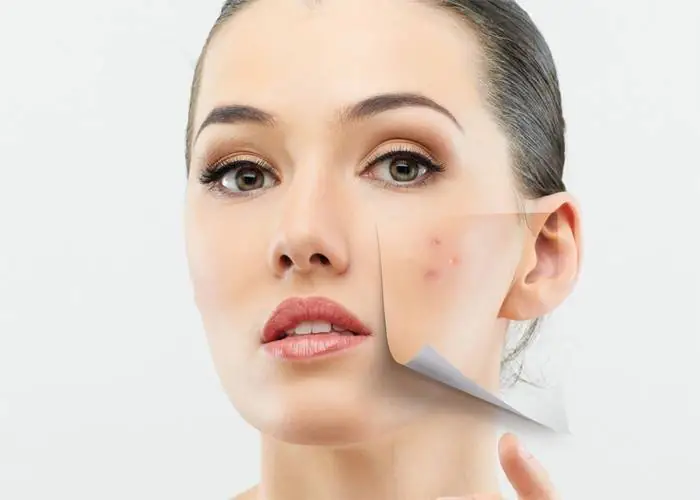
Inflammation affects the inner layers of the skin, and its superficial keratinized layer creates an obstacle to the normal cleaning of the sebaceous ducts. For this reason, it is difficult to get rid of subcutaneous acne, whether it is small white rashes or one large inflamed subcutaneous area. Such formations are located in the deep layers of the skin and “ripe” for a very long time, and therefore it is impossible to remove accumulations of sebum and pus from them using conventional methods.
Reasons for appearance
Having understood what subcutaneous acne is and what is the mechanism of its formation, it is necessary to find out what causes it. The main reason for the appearance of such rashes is a disruption in the process of sebum secretion, and it develops under the influence of a number of internal pathologies or external adverse influences. Why do subcutaneous lesions appear? Experts name the following factors that contribute to or provoke their formation:
- improper or insufficient skin care;
- hormonal imbalance associated with puberty, pregnancy, contraceptives, or endocrine diseases;
- overheating or hypothermia of the body;
- poor nutrition;
- abuse of peeling or tanning;
- disturbances in the gastrointestinal tract;
- reduced immunity;
- metabolic disease;
- hereditary predisposition;
- gynecological diseases;
- subcutaneous mite;
- bad habits (tobacco use, alcohol use).
On the face
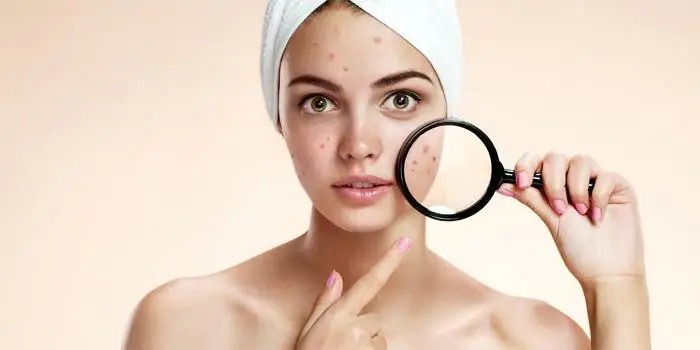
Problems with facial skin, manifested in the form of subcutaneous acne, often indicate hormonal imbalances in the body:
- If small bumps appear on the face that do not go away for a long time, this may be a consequence of developing endocrine pathologies or temporary hormonal imbalance due to natural causes (adolescence, pregnancy).
- In women, white pimples on the face can occur due to ovarian dysfunction caused by polycystic disease. In this case, they are localized on the chin and on the lower cheeks.
- In people with oily or thick skin, internal acne on the face appears due to excessive sebum production and can be located anywhere - on the forehead, nose, cheekbones, chin.
- Painful lumps on the lips that initially look like pimples may be a sign of herpes.
On the back
The appearance of subcutaneous lesions on the back can also be a consequence of sudden hormonal changes, but this phenomenon is often observed in athletes or people leading an active lifestyle. During physical activity, the back constantly sweats, and this contributes to the contamination of the sebaceous ducts and the accumulation of sebum in them, leading to the development of the inflammatory process and the appearance of acne. Find out how to remove acne on a woman's back.
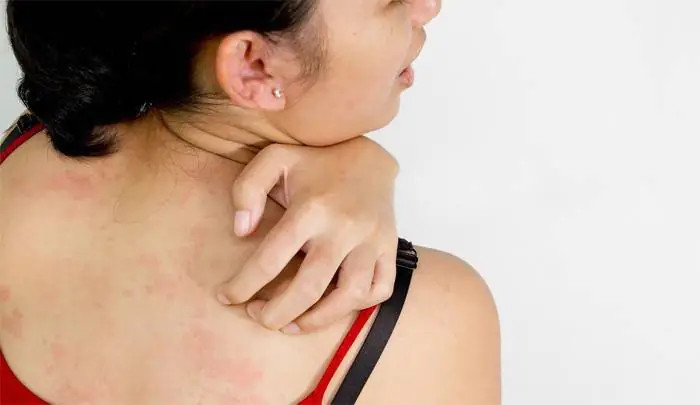
On the neck
Rashes on the neck, located in the deep layers of the epidermis, rarely occur, since the skin in this part of the body is thin. If such pimples appear in this area, it is recommended to undergo a comprehensive medical examination, since they may be associated with diseases of the internal organs or the beginning of the development of pathological processes in the body.
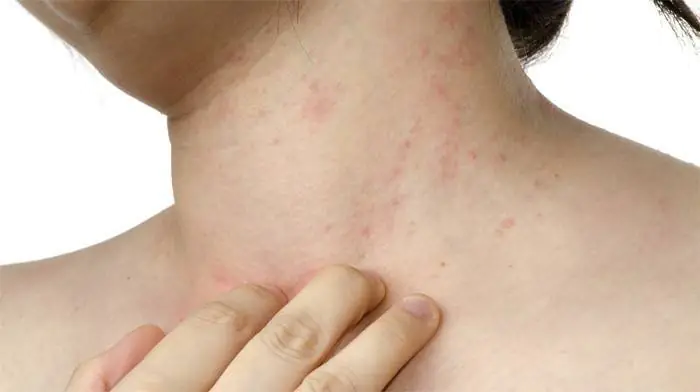
On hands
The appearance of subcutaneous rashes on the hands may indicate endocrine disorders, allergies, and hereditary diseases. If acne appears below the elbow or in the area of the hands, this should be especially alarming, because in these areas there are fewer sebaceous glands and the appearance of skin formations on them can indicate serious pathologies and malfunctions of the body.
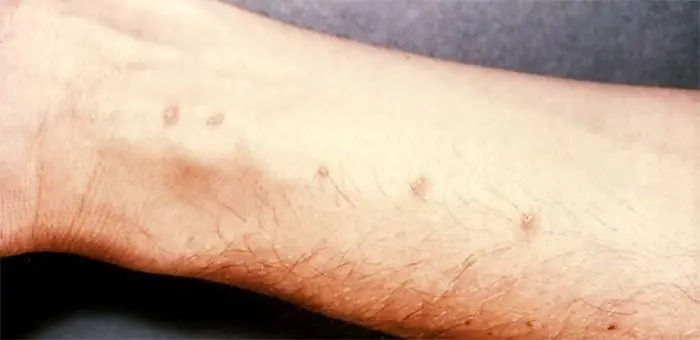
On the labia
Subcutaneous formations in the genital area in many cases occur due to hypothermia of the body. They may appear after a cold, swimming in cold water or improper hardening. Other possible causes are microtraumas that occur during hair removal in the bikini area, as well as wearing synthetic underwear, which irritates the skin and causes it to overheat.
Subcutaneous bumps all over the body
If subcutaneous rashes are located throughout the body, this may be a manifestation of a genetic disease - hereditary lipomatosis. With this disease, bumps can appear on any part of the body - neck, arms, legs, stomach, back. This disorder requires careful examination and long-term complex therapy, and sometimes surgical intervention.
How to get rid of internal pimple
If there are a lot of subcutaneous formations and they do not go away for a long time, it is unlikely that you will be able to get rid of them on your own. In such cases, consultation with a dermatologist and special therapy are necessary. The same applies to such an unpleasant manifestation as acne on the face located deep under the skin, the treatment of which must be carried out under the supervision of a specialist.
However, if the pimple is single and has appeared recently, you can try to remove it without seeking medical help by using available pharmacy and home remedies. How to remove the subcutaneous tissue? Such pimples “mature” for a long time, over several weeks, so attempts to squeeze them out will be unsuccessful. How to treat the skin to speed up this process and prevent complications from developing?
Ointment
An excellent remedy for combating subcutaneous skin are Vishnevsky ointment, Levomekol, and zinc ointment. How to pull out a pimple using these drugs? Ointments should be applied to the affected areas at least 2 times a day. In addition, compresses made from ichthyol ointment have a good effect, drawing the contents of the subcutaneous tissue out. It is recommended to apply them at night.
Cream for subcutaneous acne
When treating subcutaneous rashes, creams with an antibacterial and healing effect are helpful, allowing you to quickly stop the inflammatory process and accelerate tissue regeneration in the affected area. The most effective products in this category, recommended for the fight against subcutaneous skin, are the creams “Baziron”, “Differin”, “Skinoren”, “Klenzit-S”.
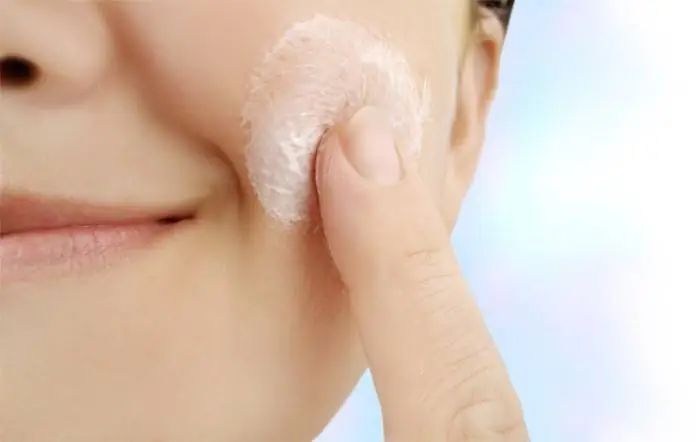
Treatment with folk remedies
Simple folk recipes that are available for use at home will help eliminate subcutaneous formations:
- Aloe compress. It helps well to get rid of such an unpleasant phenomenon as a long-lasting purulent pimple that cannot burst on its own. Cut an aloe leaf, apply it to the site of inflammation and secure with a bandage. It is most convenient to apply the compress at night.
- Tea tree oil. Apply it to your pimples every 3-4 hours for a few days until you notice improvement.
- Mask of oil and garlic. Lubricate the problem area with vegetable oil, and then precisely apply chopped garlic to the area of inflammation and place gauze soaked in hot water over it. Leave on for 20 minutes and rinse off.
How to squeeze a pimple
When deciding to squeeze out a pimple located deep under the skin, it is very important to remember the high risk of infection, even wider spread of rashes or scarring on the skin. A fully mature pimple can be squeezed out after first disinfecting your hands and treating the wound with an antibacterial solution. However, the removal of multiple formations must be entrusted to a dermatologist or cosmetologist.
Video: how to cure an internal pimple
Once and for all, special video materials will help you deal with the problem of subcutaneous rashes, in which this topic is covered in as much detail as possible. Experts talk about the main reasons for the appearance of such formations, provide photos of common types of rashes, explain how to deal with them and how to properly remove a pimple located in the deep layers of the epidermis.
Subcutaneous acne on the face causes a lot of inconvenience and discomfort in aesthetic terms. But you should worry not only about this, because they are a consequence of the inflammatory process that has arisen in the sebaceous glands against the background of purulent concentration in the subcutaneous tissues (or exudate). Such conditions are an excellent environment for the intensive proliferation of bacteria. In serious cases, this process is accompanied by cystic formations.
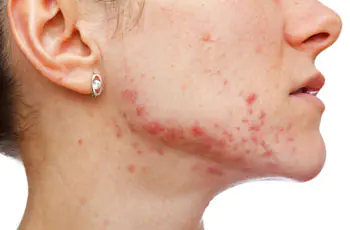
Causes and mechanism of formation of internal pimple on the face.
Subcutaneous acne is not only a problem for young people (about 80%), they can also appear in adults (40%). The main reason for the appearance of subcutaneous acne is the inflammatory process in the sebaceous ducts, which are located deep in the skin. This is due to an increase in the level of androgens (male sex hormones) in the body, as a result of which there is excessive production of sebum, which, in turn, accumulates in the excretory sebaceous ducts and attracts bacteria that feed on this sebum and multiply intensively. Against this background, inflammation develops. The keratinized layer of epithelium or dead surface skin cells clog the outlet of the sebaceous glands, and continued inflammation and infection of the affected area leads to the appearance of a reddish, hard-to-touch lump, which we call a subcutaneous pimple. Other factors can provoke inflammation of the ducts of the sebaceous glands and, as a result, the occurrence of subcutaneous acne.
Factors that provoke the appearance of subcutaneous acne.
- Hormonal imbalance due to puberty, menopause, pregnancy and lactation, taking hormonal contraceptives and medications, the presence of sexually transmitted and neuroendocrine diseases.
- Disorders of the sebaceous glands.
- Dermatological diseases.
- Insufficient or improper skin care.
- Abuse of peelings.
- Unhealthy diet with excess fatty, sugary, sugary foods.
- Violation of cell immunity.
- Genetics.
- Subcutaneous mite (Demodex).
Symptoms and signs of subcutaneous pimple.
The formation of a subcutaneous purulent pustule externally manifests itself in the form of a small hard growth of a reddish or white color, rising above the surface of the skin. As the compaction matures, a bright red tubercle appears, upon pressing which a painful sensation occurs. The size of a red subcutaneous pimple can range from 1-2 mm to 1 cm or more.
Often, with large purulent accumulations, acne growth increases. In advanced cases, large nodes make the skin lumpy with an unhealthy reddish tint. Such formations are localized mainly in areas most susceptible to the development of the inflammatory process (face, chest, back, neck, shoulders, arms).
Red subcutaneous pimples may not form purulent pustules for a long time, accompanied by unpleasant itching and pain when pressed.
If the cause of acne on the face is a subcutaneous mite, then the bright red subcutaneous lumps have multiple distributions and are accompanied by severe itching and flaking of the skin.
The success of treating subcutaneous pimples (acne, acne) depends on the correct identification and elimination of the cause that provoked their appearance.
Consequences for the skin.
Subcutaneous acne affects the external attractiveness of the skin, adding to its owners a lot of complexes about this. In addition, if treated incorrectly, they can leave spots and scars behind (post-acne).
Never squeeze pimples! This leads to the spread of bacteria and acne damage to new areas of the skin, and sometimes blood poisoning, because when squeezed out, the purulent contents directly enter the blood vessels, spreading it throughout the body. By the way, any type of cosmetic skin cleansing is also prohibited, because the procedure itself is nothing more than squeezing out pimples.
Treatment of subcutaneous acne on the face.
Treatment of subcutaneous acne depends on the degree of skin damage. If there are up to 10 such elements on the face (mild degree or first stage), treatment should be exclusively external. In this case, it is necessary to use cosmetics whose action is aimed at reducing sebum, fighting microbes, and eliminating hyperkeratosis. These products include cleansers and mattifying agents (gels, tonics). To treat acne, external gel Differin is effective. Any medications and cosmetics should be selected by a dermatologist and cosmetologist.
The average degree of acne damage to the skin (or the second stage) is when you have from 10 to 40 elements on your face. At this degree of development of acne, internal and external treatment is indicated. External treatment consists of using the same external agents as for mild lesions. But for internal treatment, the doctor individually selects hormonal contraceptives, one of the directions of which is the fight against moderate or moderate acne (pimples or acne). The contraceptive also reduces the level of male sex hormones. Additionally, an antibiotic is prescribed orally (for example, Doxycycline), which should be taken for three months. This is due to the fact that the skin renewal process occurs once every 28 days. Three skin renewals must take place in order for the face to become clean and smooth.
The third degree of skin damage (or third stage) - when there are more than 40 elements on the face, almost the entire face is covered with acne. In this case, the treatment is more serious. The drug retinoic acid (derivatives) is prescribed orally. The only such drug is Roaccutane. There is no external treatment for this degree of skin damage. The drug blocks the release of sebum from the sebaceous glands, depriving microbes of “food”, causing drying of the skin. The drug should be prescribed exclusively by a medical specialist; it gives an effective result.
Methods of treatment and elimination and consequences of acne on the face.
- Microdermabrasion - perfectly removes dead layers of epithelium, increases blood circulation, improves regeneration and recovery processes.
- Acid peeling – cleanses the skin of dead skin cells, accelerates tissue regeneration, and increases skin elasticity.
- Laser resurfacing – removes dead skin cells using a laser beam, the procedure improves tissue metabolism and accelerates their recovery.
- Physiotherapeutic and hardware methods for the treatment of subcutaneous acne (applicable only for mild to moderate lesions).
- Phototherapy – accelerates regeneration processes in cells.
- Ozone therapy - eliminates swelling and inflammation, eliminates pathogenic microbes, reduces pain, stimulates the production of collagen and elastin fibers through exposure to oxygen.
- Elos therapy - exposure to inflamed areas with blue light pulses.
- Mesotherapy – elimination of inflammation and restoration of the skin.
Home methods for treating subcutaneous acne on the face (relevant for mild skin lesions).
Before cleansing the skin, it is effective to take steam baths based on infusions or decoctions of chamomile, celandine, calendula, mint, and sage. Herbal decoctions are also good to use for daily washes or lotions (wipe the skin several times a day). To prepare an infusion of herbs, take a tablespoon of the raw material, pour 200 ml of boiling water and leave for half an hour, strain. To prepare the decoction, do everything the same as for the infusion, only the brewed herb should be additionally simmered over low heat for five minutes, then allowed to cool and strain.
Tea tree oil is a powerful natural antibiotic. It can be applied directly to pimples several times a day.
You can apply iodine to single pimples, do it quickly and carefully, literally touch it with a cotton swab. It is important to be careful here, otherwise you may get a skin burn.
Ichthyol ointment (Vishnevsky ointment) perfectly draws purulent exudate out and lubricates pimples.
Synthomycin emulsion mixed with warm boiled water (1:1) serves as a good tonic (wipe twice a day) that accelerates the healing process.
Tar soap has an excellent antibacterial effect; use it instead of cleansers.
Aloe will help speed up the release of pus from a pimple; it is recommended to cut a fresh leaf in half and apply it to the pimples overnight, securing it with a band-aid. In two days the pus will come out.
For mild skin lesions, it is good to lubricate pimples with calendula tincture in alcohol (can be bought at a pharmacy).
Aspirin also relieves inflammation well, improving skin condition. To do this, apply a mixture of aspirin and water to the spots twice a week (crush the tablet into dust and mix with water to form a paste-like mixture). There is no need to rinse off the mixture.
A decoction of birch buds helps reduce inflammation and pain from red internal pimples. For the decoction, you need to brew 10 g of buds with 250 ml of boiling water, put it on the stove over low heat, after five minutes, remove it and, having wrapped it well, let it brew for three hours, strain. Use daily, rubbing the skin, and additionally apply lotions to inflamed areas two to three times a day.
Homemade mask recipes for internal acne.
Anti-acne masks will also help cleanse the skin, reduce inflammation, and dry out acne.
Clay mask.
Ingredients.
Talc powder – 10 g.
Clay powder (white or blue) – 10 g.
Milk at room temperature – 60 ml.
Application.
Combine the ingredients to a homogeneous paste-like mass, which is spread on the skin and left for twenty minutes. Rinse off the mask with room temperature water.
Clay mask with lemon and calendula tincture.
Ingredients.
Cosmetic clay powder – 3 tbsp. l.
Alcohol tincture of calendula – 20 ml.
Lemon juice – 15 ml.
Application.
Dilute the clay with tincture, add lemon juice. Distribute the composition onto the affected areas and leave for about twenty minutes. Rinse off with water at room temperature.
Clay mask with yeast.
Ingredients.
Cosmetic white clay powder – 10 g.
Yeast in granules - 10 g.
Warm milk.
Honey – ½ tsp.
Application.
Combine the dry ingredients and add milk so that a mass is formed that resembles thin sour cream, into which then pour liquid honey (if there is no individual intolerance). Spread the mixture onto the skin and leave for twenty minutes. Wash off the mask with warm water.
Prevention of subcutaneous acne.
To speed up the treatment process, as well as to prevent the appearance of acne, it is necessary to lead a healthy lifestyle, eat a healthy and balanced diet, eliminate bad habits, including nutrition, take walks in the fresh air, and play sports.
Periodically use herbal infusions (chamomile, calendula, celandine, etc.) to cleanse and tone the skin.
During the treatment of subcutaneous acne, it is recommended to refrain from using decorative cosmetics, especially foundation and dense powder, they clog the pores, preventing the outflow of sebum. For excessively oily skin prone to rashes, these products are generally contraindicated.
There is no self-medication; all medications and drugs should be prescribed and selected only by a doctor.
Unfavorable climatic conditions, stress, various diseases of internal and external organs cause a person a lot of trouble. This is reflected in a person's appearance. If subcutaneous pimples of white, yellow or red color appear on the face, they not only do not decorate the person, but also bring a feeling of psychological discomfort.
The first desire that a boy or girl has about his appearance is how to get rid of subcutaneous acne on the face, even squeezing it out. Indulging our impulses, we do not think about the consequences, including negative ones.
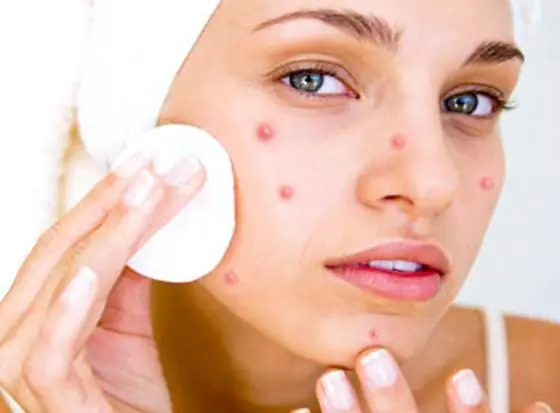
Causes
The formation of prosyanok - white tubercles, yellow and red - boils, occurs as a result of clogging of the sebaceous glands with comedones. Dead cells, dirt, and fat create a sebaceous plug at the outlet of the duct. Blockage of the outlet leads to the accumulation and stagnation of sebaceous secretions, and the infection that joins it causes an inflammatory process. Such white subcutaneous pimples on the face appear not only in young people, but also in older people. Let's look at why subcutaneous acne appears on the face.
There are various reasons for this, such as:
- hormonal disorders caused by a decrease or increase in hormone production during puberty, pregnancy, estrogen deficiency during menopause, neuroendocrine pathologies, problems with hormone production, thyroid, pancreas;
- increased proliferation of pathogenic microorganisms, leading to disruption of the functioning of immune cells;
- diseases affecting the production and flow of lipids;
- mechanical damage to the exocrine glands;
- pathologies of the gastrointestinal tract, gall bladder, cardiovascular system, infiltrative liver lesions;
- violation of personal hygiene rules;
- unhealthy diet with a predominance of sweets, pickles, spicy, fatty foods;
- metabolic disorder;
- idiopathic hyperhidrosis;
- genetic predisposition;
- parasitic diseases, helminthiasis;
- iron mite, living in sebaceous ducts, feeding on dermal cells;
- the presence of dermatitis, a sexually transmitted infection;
- colds with low immunity;
- frequent rubbing of the neck against clothing;
- cuts, wounds during shaving on the chin and cheeks of men.
Combination, oily skin serves as a breeding ground for various microorganisms, and large subcutaneous acne on the body appears much more often.
Predisposition
It would be incorrect to say that bumps occur only in young people during puberty, and it is definitely impossible to answer why subcutaneous pimples appear on the face.
There are other reasons, for example:
- hereditary chronic diseases, such as furunculosis (All about it here)
- negative impact of toxic substances: dioxin, gasoline, other fuels and lubricants;
- systematic use of oral contraceptives, anti-epileptic, anticonvulsant drugs, corticosteroids, antibiotics;
- oil-based decorative cosmetics containing hydantoin and other preservatives that release formaldehyde;
- poor functioning of the endocrine regulatory system;
- lack of zinc.
Deficiency of the latter negatively affects the process of puberty, resistance to the influence of viral infections, protein synthesis, nucleic acid metabolism, and sperm activity. In this case, a subcutaneous pimple on the body is a consequence of a deficiency of the mentioned metal. Moreover, men with a normal level of zinc in the body suffer from prostate adenoma less often.
Symptoms
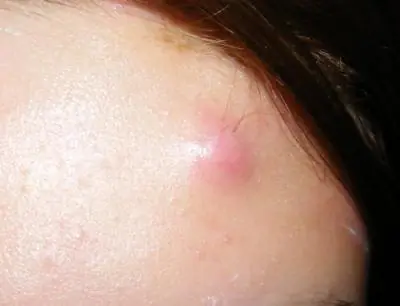
The ducts of the sebaceous glands that do not reach the surface begin to become inflamed, forming purulent pustules. In these places, the surface of the dermis becomes covered with swellings of a yellow, red, unhealthy hue. The growths vary in size from 2 mm. up to one centimeter, red subcutaneous pimples reach somewhat larger sizes.
To distinguish regular acne from cavity formation, it is enough to know the difference. For example, the latter are located quite deeper from the surface than the former. Millet or milia, red swellings take a long time to mature, sometimes more than a month, while the progenis of acne occurs much faster with its emergence.
Often large purulent growths tend to increase in number. Unpleasant itching and painful sensations accompany their maturation. The presence of more severe irritation combined with peeling is caused by damage to the skin by the iron mite - demodex. Red bumps slowly form purulent pustules, as a result of which the pathogenesis may be delayed and the intended treatment may be delayed. The consequences of the tick's work are expressed on the forehead, nose, under the red border of the lips, where many small, insignificant sebaceous glands are located. Their mechanical squeezing often leads to a population of bacteria in various areas of the skin, its qualitative deterioration, acne, and a systemic inflammatory reaction of the blood - sepsis. The presence of up to a dozen formations on the surface indicates a mild degree of damage, up to 40 - moderate, more than fifty - severe. In addition to the face, nodules can nest on the back and legs.
Treatment
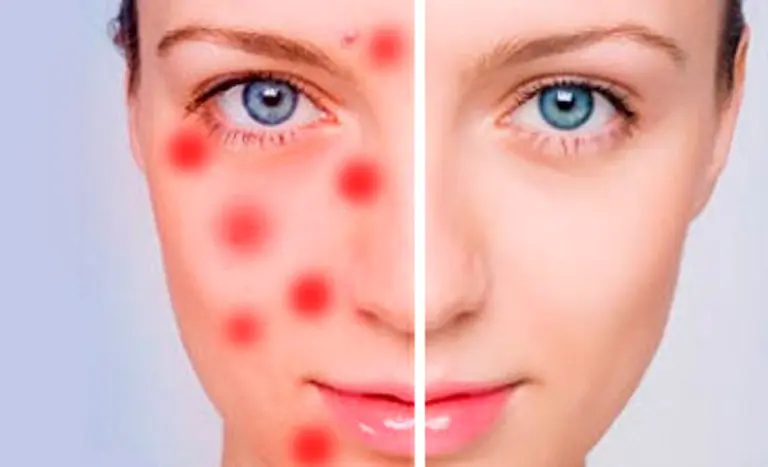
Due to the location of purulent pustules and nodules in the deep layers, it is not recommended to remove them yourself at home. Only a visit to a dermatologist or beauty salon will lead to safe skin cleansing without negative consequences. Let's look at some types of professional removal, and the question of how to get rid of subcutaneous acne on the face will disappear on its own. Most of them are designed to restore quality in cases of mild to moderate damage, while severe ones involve drug therapy.
Ozone therapy
Reduces to the introduction of ozone-oxygen injection. Allotropic modification of oxygen reduces the areas of inflammation, redness, the period of maturation of growths, and swollen areas. The composition is used to eliminate inflammatory processes, destroy pathogenic microbes, and activate the production of fibroblasts. Collagen fibers form and maintain the structure of organs, being the main proteins of connective tissue, elastin protein maintains skin elasticity.
Phototherapy
Implements treatment of formations with blue light. Penetrating into the deep layers of the dermis, it weakens, destroys the population, and stops the proliferation of harmful microorganisms. Such therapy is performed not in one session, but over two weeks with repetition of up to 5-7 procedures. Photo rays stimulate the regeneration of the integument and create the recommended temperature in the pustule cavity. The process consists of photo flashes applied to dry skin; at this time, the patient may feel a slight tingling sensation. To avoid unnecessary irritation during sessions, it is not advisable to visit a solarium, sunbathe, or use harsh scrubs or chemicals.
Phototherapy removes almost two-thirds of large tumors, small ones become less visible. At the same time, the ducts of the sebaceous glands are cleansed, their functioning, protein and carbohydrate metabolism are normalized. A repeat course is carried out no less than six months later.
Mesotherapy
Indicated by the introduction of homeopathic preparations of animal or plant origin, vitamin preparations into the mesoderm, which forms the bone and cartilaginous skeleton. The only condition for such procedures is passing an allergy test. Visible marks from injections with a thin needle are compensated by a one-time session, rapid elimination of the inflammatory process, and accelerated regeneration of the integument. This is the fastest way to remove a subcutaneous pimple from the face in physiotherapy.
Peeling
Similar sessions are also used for easy nesting of grasses, red and yellow formations. Burning the epidermis with the help of certain chemicals, in particular concentrated acids, cannot be called a pleasure, and neither is it a method of treatment. At this stage, the consequences of growths are removed, the outer layer is renewed, the ducts of the sebaceous glands are cleaned of foreign particles and fat, lumpy irregularities are leveled, and visible scars are softened.
Laser
Laser beams eliminate some external defects in the form of removing shallow fine wrinkles. The procedure is designed to accelerate the flow of oxygen to the restored areas, stimulate the production of fibrillar protein - collagen, which affects the strength and elasticity of the dermis and connective tissues of the body.
Dermabrasion
It is an equally effective way to get rid of annoying neighbors. It consists of mechanical peeling with deep grinding of each layer separately, when the damaged area is removed with a special abrasive cutter.
Despite the fact that this procedure is painful and cannot be done without painkillers and anti-inflammatory drugs, it is a success. Deep wrinkles and darkened areas disappear, lumpy surfaces are smoothed out, however, this does not happen as quickly as we would like, several sessions are carried out after 1-2 months. Mechanical cleansing can be replaced with laser, diamond or microdermabrasion at the request of the patient. After the regeneration of the dermis, the question of how to remove a subcutaneous pimple from the face will become a thing of the past.
Medication
Physiological and cosmetic products relieve the body of defects with mild to moderate damage. Numerous nesting formations require the use of medications. Then, how to treat severe subcutaneous acne on the face?
Antiseptic liniments suppress the growth and reproduction of pathogenic bacteria and iron mites. Among the antiseptics, the following ointments can be distinguished: Betadine, Dioxidin, Levomekol. The products have an immunostimulating effect, destroy populations of most pathogenic bacteria, the presence of pus in the papules does not affect the action of the drugs. Do not forget about the old proven methods - Vishnevsky ointment (read all about this ointment here), ichthyol, zinc.
In severe cases, a remedy for papules is prescribed in the form of retinoic ointments: Retinol Acetate, Isotretinol, Bexarotene, or pulling ointments can be used. They reduce the synthesis of fat, which affects the speed of cleansing of the ducts of the sebaceous glands, and cope with formations caused by bacteria. They contain zinc, an antibiotic, accelerate regeneration, healing of open purulent wounds, and drying.
Damage caused by hormone deficiency is cured by the presence of estradiol: Dermestril, Divigel, Klimara. They increase the level of endogenous estrogens, reduce sweating, headaches, and normalize sleep. Improves the metabolism of proteins, fats, carbohydrates, and mineral metabolism.
Folk remedies
Traditional medicine also tells you how to cure annoying bumps. Ointments with tea tree oil, infusions with medicinal chamomile, aloe, onion masks with honey, aspirin, clay masks, Kalanchoe, lemon, decoctions of birch buds, green tea.
Prevention
Treatment of papules comes down not only to their quantitative reduction, but also to prevention in case of disposal. In order not to constantly wonder how to get rid of subcutaneous acne on the face, it is necessary, first of all, to get rid of bad habits, eat right, and adhere to the rules of personal hygiene. Daily washing with properly selected gels, lotions, soft cleansing scrubs, moisturizing emollients, herbal baths will help with this.



